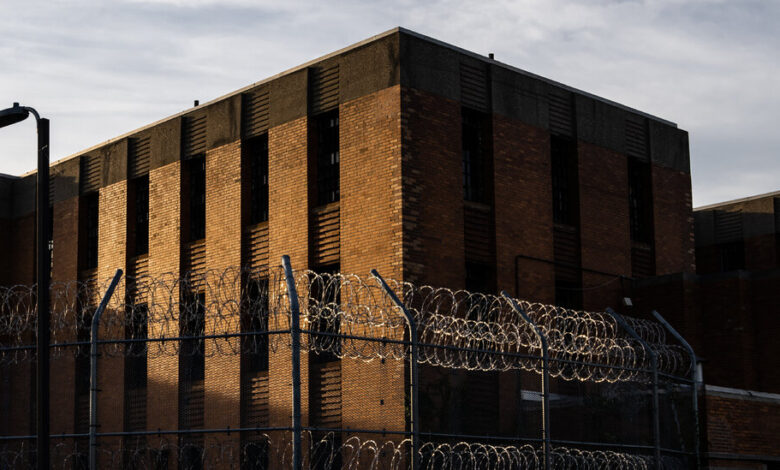City’s Admissions That It Can’t Care for Rikers Detainees May Propel Suits

The security-camera images tell a remarkable story: A man being held on Rikers Island collapses and is carried to a medical clinic — not by the correction officer outside his housing unit but by other detainees. The man, Herman Diaz, 52, who had choked on an orange slice, did not survive.
This week, Mr. Diaz’s family filed a lawsuit in federal court in Manhattan seeking $20 million in damages. The suit relies on reports and court documents created by the city itself over the past two years that acknowledge that New York cannot adequately care for the people in its jails. If the suit succeeds, it could provide a road map for more than two dozen other families whose relatives died in custody.
The Rikers Island jail complex has been troubled for decades, but the coronavirus heightened the suffering of those on the island, prolonging the stays of detainees as the court system ground to a halt.
The virus hit correction officers hard in 2020, infecting more than a thousand and killing six. This led to widespread absenteeism, with thousands failing to show up for work each day. The quality of life for detainees dropped steadily, threatening their access to food, water and medical care. Since January 2021, 27 people have died while in custody or shortly after being released.
One was Mr. Diaz, whose March 18 death, like several others, has been well documented by city agencies. In May, an oversight board that monitors the jails, the Board of Correction, issued a report on the circumstances that led to the deaths of Mr. Diaz and two other detainees.
The Crisis at Rikers Island
Amid the pandemic and a staffing emergency, New York City’s main jail complex has been embroiled in a continuing crisis.
- Inside Rikers: Videos obtained by The Times reveal scenes of violence and offer vivid glimpses of the lawlessness that has taken hold.
- Decades of Dysfunction: For years, city officials have presided over shortcuts and blunders that have led to chaos at the jail complex.
- A Teen’s Suicide Attempt: Several correction officers stood by for minutes as an 18-year-old detainee tried to hang himself in a jail cell. They have been charged with misconduct.
- Solving the Crisis: City officials, under pressure to put an end to the violence, had risked a federal takeover. A judge granted them more time to address the situation instead.
The report found that the officer posted outside of Mr. Diaz’s unit that day was not permitted to work with detainees and did not apply the Heimlich maneuver, leaving the others living there to carry Mr. Diaz to the medical clinic. They passed other officers on the way to clinic, but none gave Mr. Diaz medical assistance. He died at 10:58 a.m., about 42 minutes after he began to choke.
Sonia Talavera, Mr. Diaz’s younger sister, was in her kitchen when she received a phone call notifying her of his death.
“I just broke down,” she said. “I’m sure it could have been avoided. If they had the right equipment and the right people, they would have saved him. A lot of people choke, and most people get saved.”
In a report released this summer, the city comptroller, Brad Lander, noted that claims against the Department of Correction had declined after peaking in 2017, and that payouts in 2021 had dropped to $28.1 million, the lowest in six years. But, Mr. Lander noted, a recent influx of filings related to the department “may result in higher payouts in future years.”
In a statement, a spokesman for the city’s Law department, Nick Paolucci, said, “Any death in custody is tragic. The problems in the jails have been longstanding, and they cannot be fixed overnight.” He added that the city was committed to working diligently with a federal monitor who oversees the jail system “to implement enduring reforms.”
The Board of Correction report that includes Mr. Diaz is among several documents in which the city has documented the way it struggles to care for those in its custody. In a separate court case brought on behalf of a class of detainees, the city acknowledged circumstances when it was unable to ensure access to medical care.
Lawyers say that these types of admissions will work in favor of plaintiffs like Mr. Diaz. Julia Kuan, a civil rights and criminal defense lawyer in Manhattan who has sued the city on behalf of incarcerated people, said that they provided substantial evidence.
“All of those admissions by the city is evidence that can be used in a lawsuit,” she said. “That is strong evidence of liability.”
Indeed, lawyers for the family of another detainee who died at Rikers this year, Mary Yehudah, said they planned to include the city’s admissions about the lack of access to medical care. “It very much plays into the claims we’re going to have,” said Ilyssa S. Fuchs, one of the lawyers.
“We can view many of the deaths that we’re seeing at Rikers now, as they stack up one after another, as evidence of a systemic breakdown,” said Josh Kelner, who, along with another lawyer, Neil Wollerstein, is representing Mr. Diaz’s family.
This year, federal prosecutors and lawyers for those at Rikers raised the prospect of a federal court takeover of the jail complex, which is slated to close by 2027. But New York City fought back, and a federal judge decided to allow the city a grace period during which it will implement a plan to reform Rikers.
For Ms. Talavera and other family members of those who have died in city custody, plans for reform come too late. She called for Rikers to be shut down.
“It shouldn’t be open,” she said. “They don’t care for people’s lives there.”